Posted by Elena del Valle on July 23, 2010

La belleza de saber vivir book cover
Photo: Grupo Nelson
Barbara Palacios, Miss Universe 1986, banked on her beauty queen reputation to gain the attention of potential readers and fans for a Spanish language book she published recently in the United States. In La belleza de saber vivir 9 pasos para conducir tu vida (Grupo Nelson, $14.99) she shares insights about her philosophy of life and the importance of religion in her life.
The 224-page hardcover book is divided into nine chapters, one for each of the nine steps she proposes her readers follow to live a fulfilling and faith oriented life: La Aceptación, El Enfoque, El Equilibrio, El Liderazgo, El Optimismo, La Gratitud, El perdon, La Dignidad and La Fe. The chapters represent what she considers life’s important paths: acceptance, vision, balance, leadership, optimism, gratitude, forgiveness, dignity and faith.
According to her biography, Palacios’ business ventures include several advertising agencies. She also leads her own company, BP Group featuring her own line of jewelry, beauty products and several stores that bear her name across the United States. The motivational speaker lives in Miami with her husband and two sons.

Click here to buy La belleza de saber vivir (Spanish Edition)
Comments:
Filed Under: Books
Posted by Elena del Valle on July 16, 2010

Mañana in Cuba
Photos: Tara Inc.
In Mañana in Cuba The Legacy of Castroism and Transitional Challenges for Cuba (Authorhouse, $24.95), a 184-page English language softcover book published this year, Jose Azel, Ph.D. addresses the possible future situation in Cuba, the country of his birth. He examines the issues that he believes afflict the island nation with an emphasis on challenges and opportunities.
In the book, he offers policy approaches based on what he assesses to be the current situation and Cuban mindset on the island he has not seen since his youth. He also discusses the potential benefits he sees for the United States if the Castro ruled nation one day becomes a democracy. And, he explores the concept of Choice Architecture based on “the lessons learned in Eastern Europe.”
“The book is a little history, political science, a little philosophy, psychology, sociology just very multidisciplinary which I think reflects my own thinking,” said Azel. He explained by phone that although much has been written about the past of Cuba this book is novel because of its focus on that country’s future.
The University of Miami logo and the words “Institute for Cuban and Cuban-American Studies University of Miami Coral Gables, Florida” appear at the beginning of the book. One hundred percent of the author proceeds of the book are designated to benefit the Institute with which he is affiliated.
The book is divided into two parts and thirteen chapters. The chapters in Part One are: Cuba: Alternative Roads in an Uncertain Future; Freedom from Fear; Search for Meaning; The First Law; No Le Pidas Peras Al Olmo; Carajo, Somos como Somos; Cuban Informality and Choice Architecture; and The Pursuit of Happiness. The chapters in Part Two are: Personnel Reforms; Institutional Reforms; Political Reforms; Economic Reforms; and Concluding Thoughts.
In his conclusion Azel states that “The most insidious and devastating legacy of Castroism is that Cuban society, living in constant fear, has forgotten how to feel free.” And that “… promoting a Cuban society that relearns how to feel free should be a common denominator of all mañana in Cuba visions.

Author Jose Azel, Ph.D.
Azel left Cuba in 1961 as a 13 year-old political exile in the Operation Pedro Pan, a child refugee program. A senior scholar at the Institute for Cuban and Cuban-American Studies (ICCAS) at the University of Miami he dedicates his time to the in-depth analysis of Cuba’s economic, social, and political state. He has a particular interest in post-Castro Cuba strategies. It took him a year of intense writing to complete the book.

Click here to buy Mañana In Cuba
Comments:
Filed Under: Books
Posted by Elena del Valle on July 9, 2010

Living Trusts for Everyone book cover
Photos: Allworth Press
Since Attorney Ronald Farrington Sharp switched his practice from family law to estate planning he became convinced that for most of his clients advance planning would help them save on after death fees. In legal terminology he believes a trust is better than a will and less expensive too. Many people are familiar with a will but what is a trust?
In his recently published book, Living Trusts for Everyone Why a Will is Not the Way to Avoid Probate, Protect Heirs and Settle Estates (Allworth Press, $14,95), he explains both concepts and the misconceptions involved in each of them. He believes wills benefit attorney and trusts benefit families. Unscrupulous attorneys drive the business of probate and wills in order to make a percent of the monies in the estate when their clients pass away, he says. Instead he proposes readers consider relying on trusts to avoid the probate process and to reduce estate taxes as well as for easier management of their assets for children and disabled heirs.
According to Farrington Rich clients do not have to be wealthy to benefit from a trust. In the 147-page softcover book, he shares ways for readers to avoid expensive legal fees, protect heirs, and settle estates. He discusses the different types of trusts, funding a trust, the role of trustees and guardians, selecting an attorney to draft the trust; what establishing a trust should cost, and who should establish a trust. he explains that there are dozens of trust types. Although he does not specifically focus on trusts from a business perspective many of the issues he raises about wills and trusts likely interest business people and business owners as they refer to the protection and inheritance of estates and assets.
The book is divided into twelve chapters: Trusts and Wills Defined; You Must Have a Trust If; A Comparison: Trusts and Wills; Trust Seminars: A Free Meal, But at What Cost; Watch Out for Attorneys; Trustees; Making Your Trust Work: Funding; You Do Not Need a Trust If; The Many Types of Trusts; Problems with Trusts; Guardians, Powers of Attorney and More; and Trustee Instructions for Death or Disability; and three appendices.

Author Ronald Farrington Sharp
Farrington Sharp is the founder of Ronald Farrington Sharp and Associates Law Firm established in 1975, and owner of the Michigan Law Clinic in Wayne, Michigan and the Great Lakes Legal Clinic in Southeastern Michigan. According to promotional materials, he has prepared over 3,000 trusts and estate plans. Prior to writing this book he authored Winning the Divorce War. He divides his time between Michigan and Florida.

Click here to buy Living Trusts for Everyone
Comments:
Filed Under: Books
Posted by Elena del Valle on June 11, 2010
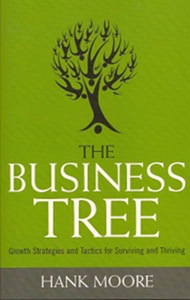
The Business Tree book cover
Does your company have a business plan? Do you know what it is? If the answer is no. You are not alone. Only 2 percent of the businesses of the world have functioning strategic plans. At the same time most businesses (82 percent) and almost all (98 percent) of new businesses are small and emerging businesses. So far so good for entrepreneurs. The discouraging news is that 70 percent of new businesses go under in the first five years and 90 percent do so within 10 years. Many business owners may already be familiar with these statistics.
What they may not know is that 83 percent of businesses in the United States employ 20 people or less and only a mere 7 percent employ 100 or more. Although Hispanics own 7 percent of businesses in the United States 98 percent of Hispanic-owned businesses have 50 employees or less*.
What causes so many entrepreneurs to remain small or to lose their way and fail? Hank Moore, who makes a living advising companies on ways for them to remain healthy and profitable in the future, is convinced a plan for growth is essential for companies who want to be around past the initial years.
Also, to be competitive companies have to have a strategic plan that outlines their long term future and the tools that allow them to adapt to changing market conditions. Often he finds the companies that get into trouble are those that failed to plan properly from the start. He estimates that it costs six times as much to make adjustments to a company midway compared to one that set out with a strategic plan from the onset.
In his recently published book, The Business Tree Growth Strategies and Tactics for Surviving and Thriving (The Career Press, $15.99) Moore shares some of the wisdom he has acquired during a career as a corporate strategist.
The 224-page paperback book is divided into 10 chapters. The tree part of the title refers to the organization itself while each branch represents a component or aspect of the company. According to his biography, Moore, who specializes in big picture issues, has advised 5,000 clients including 100 of the Fortune 500.
*See Hispanic Business magazine May 2010

Click here to buy The Business Tree
Comments:
Filed Under: Books
Posted by Elena del Valle on June 4, 2010
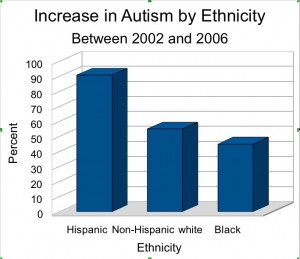
Click on image to enlarge (Source: CDC, Chart: HispanicMPR)
The incidence of autism is increasing. In a December 2009 report by the United States Centers for Disease Control and Prevention (CDC) about the condition, the government researchers confirmed that the prevalence of autism spectrum disorders in the United States is 1 percent of the population, or one in 110 of children 8 years of age in 2006.
This may alarm some people because autism has been a much misunderstood developmental condition. Autism sufferers are unable to interact normally within society. According to the National Institute of Neurological Disorders and Stroke, Autism Spectrum Disorder (ASD) “is a range of complex neurodevelopment disorders, characterized by social impairments, communication difficulties, and restricted, repetitive, and stereotyped patterns of behavior.”
Boys are four times more likely to suffer from autism than girls. The disorder occurs across ethnic, age and socioeconomic groups. Increases of autism among children including some minorities between 2002 and 2006, according to the CDC report, were significant: there was a 91 percent increase in Hispanic children (noteworthy was a 144 percent increase in Arizona); a 41 percent in black non-Hispanic; and a 55 percent increase in white non-Hispanic.
At the same time, it seems possible Hispanic children are diagnosed accurately with autism less frequently than other children. A Reuters Health article refers to a 2009 American Journal of Public Health article that in turn cites a study in Texas schoolchildren that may indicate Latino children in that state are under diagnosed because they are less likely to have health insurance or access to medical care. Is it possible this is the case in other states?
According to a recently published book, every 20 minutes a child is diagnosed with autism. Yet no one knows why cases of autism are increasing worldwide.

Author William Stillman
William Stillman, an adult sufferer of Aspeger’s Syndrome (a milder condition on the autism spectrum), has explored and written about the issue extensively. This year, he published The Autism Prophecies How and Evolution of Healers and Intuitives Is Influencing Our Spiritual Future (New Page Books, $14.99) with the goal of revealing what he believes to be the truth about autism and its purpose.
He is convinced mind control and speaking unknown languages could be among the abilities possessed by some people with autism; that it is possible for parents to distinguish between their child’s spiritual interactions and what some might consider hallucinations; and that autism sufferers posses wisdom that may help society prepare for future hardships, resulting in a rebirth of civility, respect, and compassion.
“Given the growing rates of autism worldwide, the face of business will be required to adapt in the coming decades so that individuals with autism can contribute as taxpaying citizens, not citizens that tax an already overburdened system,” said Stillman by email when asked about the impact of autism in the business community.
“In the same manner that industries presently serve our aging population, individuals with autism will be poised for success in partnership with businesses that will adjust to meet their needs as consumers, and will redefine business approaches that tap the unique skills and talents of those same consumers. Many people with autism will always require physical care and support but their cognitive ability to problem-solve, conceptualize, and apply a rare and alternative logic can be maximized to great advantage in the future.”

The Autism Prophecies book cover
The 205-page paperback book is divided into nine chapters within three parts: Healers, Mysterious Ways and Future Forecasts. In the book, he shares comments he has received from the parents of autistic children he has met through his work and as a result of prior books he has authored. He also shares examples of what he believes are autistic sufferer’s spiritual gifts and anecdotes about the possible sensitivities of people with autism.
Described in promotional materials as an autism spectrum self-advocate, consultant, and speaker Stillman authored The Soul of Autism and Autism and the God Connection prior to writing this book. The Pennsylvania resident also wrote The Autism Answer Book, Empowered Autism Parenting, and Demystifying the Autistic Experience. Stillman also writes columns for The Autism Perspective and Children of the New Earth magazines.
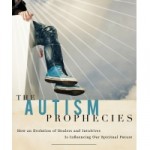
Click here to buy The Autism Prophecies
Comments:
Filed Under: Books
Posted by Elena del Valle on May 14, 2010

Managing Hispanic and Latino Employees
Photo: Berrett-Koehler Publishers, Inc.
Louis E. V. Nevaer, author of several books and director of Hispanic Economics, wrote Managing Hispanic and Latino Employees A Guide to Hiring, Traing, Motivating, Supervising and Supporting the Fastest Growing Workforce Group (Berrett-Koehler Publishers, $24.95) a book, published January 2010 about managing Hispanic employees. Relying on estimates that 25 percent of the domestic workforce is of Latino heritage and researcher predictions that Hispanic workers will represent more than half of the country’s workforce by 2050, the writer promises practical advice and his conclusions, based on research data, of what he believes are unique cultural issues in hiring, motivating, training, supervising, developing, retaining, and managing Hispanic workers.
“American business is confronting a crisis of confidence in its ability to identify, cultivate and nurture Hispanic Talent. In 2005, Hispanics in comprised 14 percent of the nation’s population, but constituted 22 percent of workers today,” said Nevaer by email from Mexico when asked why he wrote the book. “That Hispanics are almost a decade younger than the population at large means that Hispanics, Latinos and Latin American immigrants, disproportionately, are of working age, either leaving college and entering the workforce, or well on their way to establishing their careers; and Hispanics in 2050 will represent 32 percent of the nation’s population, but will comprise 55 percent of workers.
As America’s Baby Boomers and Generation X-ers mature and retire, Hispanics and Latinos, native born and Latin American immigrants alike, will dominate the workforce. This book is blueprint for helping organizations throughout the U.S. deal adequately with the changing American workforce.”
The 269-page softcover book is divided into three parts, The Hispanic Employee and American Demographics, The Strategies and Skills for Supervising Nonexempt Hispanic Employees, and The Hispanic Employee and the Organization’s Future; and 10 chapters.

Author Louis E. V. Nevaer
The author opens the book with a quote from Nobel laureate Gabriel Garcia Marquez’ famous novel One Hundred Years of Solitude and a Note on the Nomenclature in which he clarifies his use of the terms Latino, Hispanic and Latin in the book. He identifies Latinos as English dominant U.S.-born Hispanics; Hispanics as those of Latin American or Iberian ancestry fluent in Spanish; and Latins as those born in Latin America who migrated to the United States.
Nevaer is a contributor to Pacific News Service and New American Media. He is the author of over a dozen books, including HR and the New Hispanic Workforce and The Rise of the Hispanic Market in the United States.
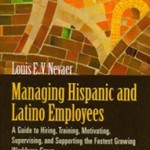
Click here to buy Managing Hispanic and Latino Employees
Comments:
Filed Under: Books
Posted by Elena del Valle on May 7, 2010

Emotional Branding
Photos: Allworth Press
In the updated and revised edition of Emotional Branding the new paradigm for connecting brands to people (Allworth Press, $19.95), a 325-page softcover book published in 2009, Marc Gobé discusses society’s migration from objective to subjective thought and rationality to desires and how it affects branding.
He examines the power of social media and the reasons he believes the way we do business is changing thanks to the Web. In the book he includes mentions of market segments such as Baby Boomers, generations X, Y and eXel, gays, and women. In Chapter 2 (pages 29 to 42), he discusses the American Melting Pot, specifically African-Americans, Asian-Americans and Hispanics.
Although he indicates that almost all industries should target U.S. Latinos he highlights eight areas where Hispanics tend to outspend non Hispanics: Food consumed at home, apparel, telephone services, rental housing, TV/radio equipment, personal care products, public transportation and cleaning supplies. He points out that brand managers need to understand what issues are most important and influential among Latinos to target their aspirational interests.
The book is divided into three sections and 15 chapters. The sections are Relationship – customer, customer, customer; and Sensorial experiences – the unchartered territory of branding; Imagination – innovation is a brand’s best friend.

Author Marc Gobé
Gobé is president of Emotional Branding, LLC, a New York think tank and consulting firm dedicated to creating “content for online experiences.” He co-founded and is former chief executive officer of Brandimage (formerly Desgrippes Gobé). The designer, photographer, filmmaker, and public speaker who dedicates his time to connecting brands emotionally with people in a positive way also authored Brandjam and Citizen Brand.

Click here to buy Emotional Branding
Comments:
Filed Under: Books
Posted by Elena del Valle on April 30, 2010
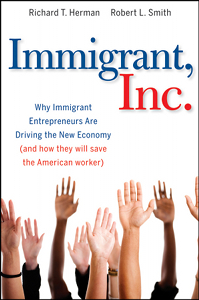
Immigrant, Inc. Why Immigrant Entrepreneurs Are Driving the New Economy
Photos: John Wiley & Sons, Inc.
Myriad uber famous companies were founded by immigrants to the United States. Examples include Google, Intel, Yahoo, Hotmail, YouTube, Sun Microsystems and ebay. In 2010, immigrants in the United States are almost twice as likely as non immigrants to establish a business. Immigrants are behind more than half the new high tech businesses in Silicon Valle; and they are more likely to earn an advanced degree, receive a patent or create an invention, according to the authors of a newly published book.
Richard T. Herman and Robert L. Smith point out that amidst all the controversy over undocumented immigrants many people overlook the critical contributions of legal immigrants to America’s business environment and economy. The immigration and business law attorney and journalist specializing in immigration issues, both Ohio residents, authored Immigrant, Inc. Why Immigrant Entrepreneurs Are Driving the New Economy (and how they will save the American worker) (Wiley, $29.95), a 226-page hardcover book about the importance and accomplishments of immigrants published in 2010.
They believe some immigrants arrive primed with ambition, education, thrifty attitudes, and family loyalty to launch their entrepreneurial dreams and find success. In turn they create businesses and jobs that fuel our economy and help our country thrive at a noteworthy rate.
The authors dedicated 10 chapters to the topic, exploring the motivations and qualifications of immigrants and examining individual immigrant’s stories. The chapters are: A Mighty New Idea; The Mounting Evidence; A Land of Opportunity, Still; Restless Dreamers; Earth’s Best and Brightest; Cowboys of a New Frontier; Desperate Achievers: Prequel to Google; Importing Solutions; The Stimulus We Need; and Thinking Like an Immigrant.

Co-author Richard T. Herman

Co-author Robert L. Smith
Herman is the founder of Richard T. Herman and Associates, an immigration and business law firm in Cleveland, Ohio. He is also the co-founder of a chapter of TiE, a global network of entrepreneurs. Smith writes about international culture and immigration for The Plain Dealer, one of the largest newspapers in Ohio.

Click here to buy Immigrant, Inc.
Comments:
Filed Under: Books
Posted by Elena del Valle on April 23, 2010

PR Therapy book cover
Photos: Quill Driver Books
In PR Therapy: Ignite Your Passion for Promoting Your Products, Services, and Even Yourself! Robin Blakely, a New York City public relations consultant, dedicates 180 pages to help readers build a public relations platform for their businesses. She focuses on print, broadcast and live media options.
In the book, she examines basic issues like the need to make changes in existing patterns of behavior, identifying assets and liabilities of the person or brand to be promoted, options available, and narrowing the target audience for starters. She shares suggestions, based on her experiences and that of colleagues, readers may want to consider to address the challenges they face along the way to promoting their business and brand.
The softcover book, published last year, is divided into six section she calls phases: Your Big Couch Trip, The RX to Analyze Your Audience, Picking and Approaching the Media, Your PR Empowerment Tools, The Media and Doing What It Takes, and Building on Your Success. These in turn are divided into what she calls sessions.
Blakely promises readers will have the tools to visualize and build a promotional base that allows them to connect with the most important areas of their market, select varied media venues to target, design the right tools for their business, understand what they need to know before beginning their promotional efforts in earnest.

A ten-year veteran in her field, Blakely is the founder of Livingston Communications, Inc. and a founding partner of Get There Media, a New York City company. She has secured promotional placements for clients at print, broadcast and live venues with HGTV, Book TV, ABC World News, and Vanity Fair among others.

Click here to buy PR Therapy
Comments:
Filed Under: Books
Posted by Elena del Valle on April 16, 2010
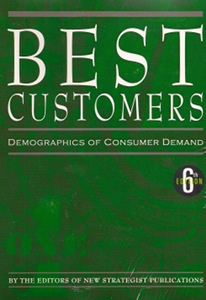
Best Customers: Demographics of Consumer Demand
Did you know that on average Asian households in America spend more than non Hispanic white households? And that black and Hispanic households spend less? At the same time, there are wide variations in some spending habits by ethnic groups. For example, Asian households spend very little on pets while blacks and Hispanics spend significantly more than other groups for children’s clothes.
Marketers wanting to prepare for trends such as the Baby Boomer generation and the rise of ethnic emerging markets like the Asian, black and Hispanic segments, which are estimated to account for one of every five dollars of purchases in America, may be interested in the detailed information about the products and services consumers bought in past years outlined in Best Customers: Demographics of Consumer Demand (New Strategist Publications, $89.95).
The 775-page softcover book breaks down purchases and spending patterns by the demographic characteristics of households based on data from the Bureau of Labor Statistics’ 2007 Consumer Expenditure Survey. The source of the previously unpublished data is surveys of household spending. The time lag between the data collection and the publication of the book, 2009, is about two years.
The book is divided into 21 chapters (in alphabetical order): Alcohol, Apparel, Computers, Education, Entertainment, Financial Products and Services, Furnishings and Equipment, Gifts for People in Other Households, Groceries, Health Care, Reading Material, Restaurants and Carry-Outs, Shelter, Telephone, Tobacco Products, Transportation, Travel and Utilities; and four appendices: About the Consumer Expenditure Survey; Percent Reporting Expenditure and Amount Spent, Average Quarter 2007; Spending by Product and Service, Ranked by Amount Spent, 2007; and Annual Average Household Spending, 2000 and 2007.
The information in the book was originally gathered by the Census Bureau to allow the federal government to track prices. Two groups of 7,000 households (technically called consumer units) each in 91 areas of the country provide the data through two different surveys which are thought to cover 95 percent of expenditures. It is not clear if undocumented residents are included in the survey. Other sources of similar data collection indicate the Consumer Report Survey data is lower than actual except for: rent, fuel, telephone service, furniture, transportation and personal care services.
New Strategist Publications publishes other demographic data titles about consumers (see Book outlines spending by race, ethnic group and New York publisher shares household spending summary) and Hispanics (see Data rich book outlines Hispanic market profile).
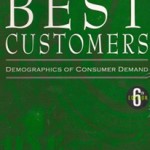
Click here to buy Best Customers
Comments:
Filed Under: Books






































